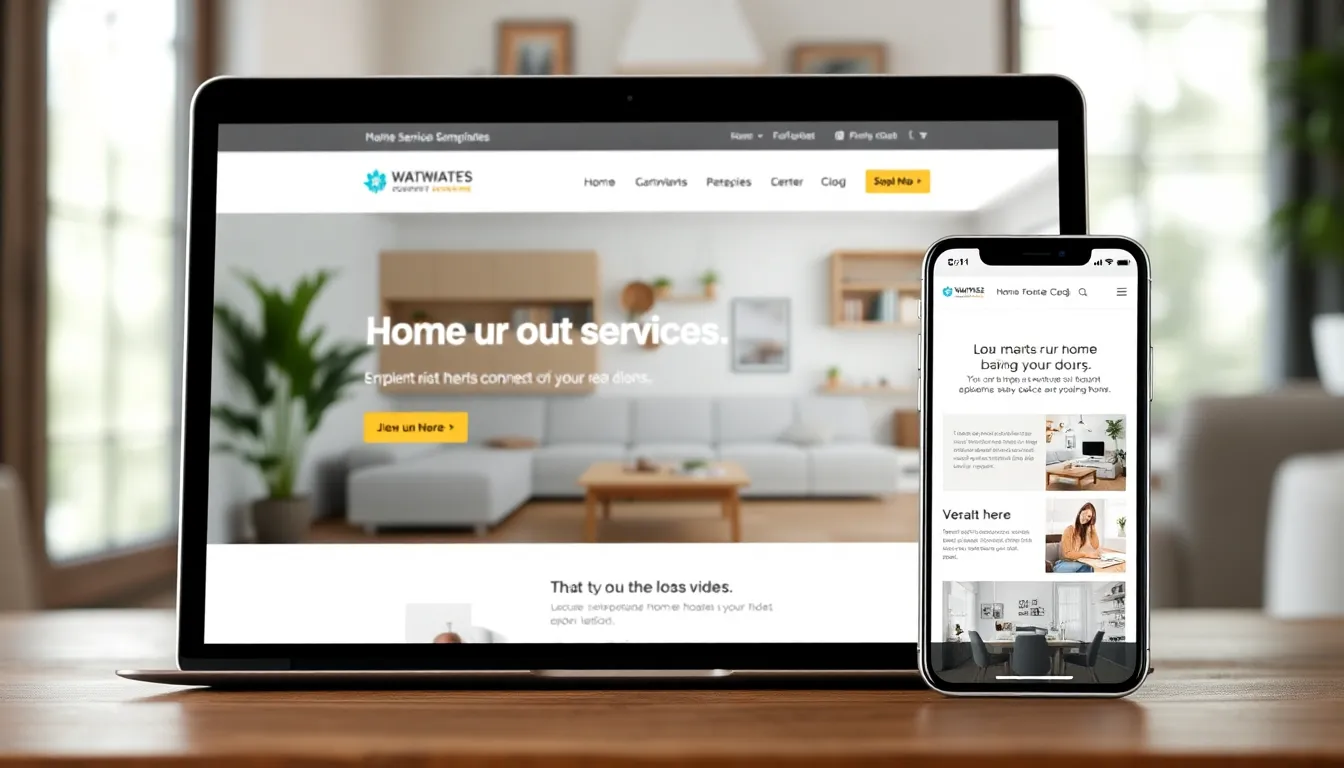In today’s digital world, a home services business without a stellar website is like a plumber without a wrench—just not gonna cut it. With homeowners turning to the internet for everything from finding a reliable electrician to booking a cleaning service, having an eye-catching and functional website is crucial. It’s not just about looking pretty; it’s about converting visitors into loyal customers.
Imagine a website that not only showcases services but also makes visitors feel right at home. A well-designed site can elevate a business from “just another service provider” to “the go-to expert” in their field. So, whether it’s optimizing for search engines or creating a user-friendly experience, investing in home services web design is the key to unlocking a flood of new clients. After all, who wouldn’t want their business to shine brighter than a freshly polished kitchen sink?
Table of Contents
ToggleOverview Of Home Services Web Design
Home services web design focuses on creating visually appealing and functional websites tailored for businesses in home repair, cleaning, landscaping, and similar industries. Clients often need straightforward navigation, making it easy to find services. Well-structured layouts contribute to effective user experiences.
Incorporating vivid images is crucial for showcasing past projects and services offered. Written content should clearly describe services while highlighting unique selling propositions. Effective calls-to-action guide visitors toward booking appointments or requesting quotes, increasing conversion rates.
Responsive design caters to various devices, ensuring seamless access for users on smartphones, tablets, and desktops. Fast loading speeds enhance user satisfaction by reducing bounce rates. SEO optimization improves visibility on search engines, driving more traffic to the website.
Integrating customer testimonials builds trust, as potential clients often rely on reviews from previous customers. Offering easy access to contact information is vital for encouraging inquiries. Various tools, like chatbots, can facilitate immediate communication, enhancing customer service.
Analytics tools allow businesses to track visitor behavior, providing insights into what works and where improvements are needed. Regularly updating content keeps websites fresh and relevant, appealing to returning visitors. Creating a standout online presence is essential for home services businesses aiming to grow their customer base.
Importance Of Web Design For Home Services

A well-designed website directly impacts the success of home services businesses. Factors such as user experience and mobile responsiveness play vital roles in attracting and retaining clients.
User Experience Considerations
User experience significantly affects how visitors interact with a home services website. An intuitive navigation system allows users to find information quickly. Clear organization of content engages potential clients, making it easier for them to book services. Incorporating appealing visuals creates a positive first impression. Fast loading times reduce frustration, ensuring users remain on the site. Effective calls-to-action encourage visitors to take steps toward engagement. Regular updates maintain relevance, further enhancing user satisfaction.
Mobile Responsiveness
Mobile responsiveness is crucial in today’s mobile-centric world. Over 50% of web traffic comes from mobile devices, necessitating adaptable designs. A website that adjusts seamlessly to different screen sizes promotes a positive user experience. Responsive designs maintain functionality, ensuring visitors can easily navigate services on tablets or smartphones. Optimizing images and content for mobile access also improves loading speeds, which directly reduces bounce rates. Implementing a mobile-friendly design enhances reach, ultimately contributing to higher conversion rates for home services businesses.
Key Features Of Effective Home Services Websites
Effective home services websites incorporate specific features that enhance user experience and drive conversions. These features include detailed service listings, clear contact options, and well-designed quote request forms.
Service Listings And Descriptions
Service listings must clearly outline the offerings with engaging descriptions. They should highlight unique benefits and features to capture attention. Each listing can include pricing, availability, and relevant visuals. Using high-quality images enhances appeal and provides an accurate representation of the services. Information must be concise yet informative to improve user understanding. Including customer reviews or ratings within service descriptions can build trust and credibility. Furthermore, using bullet points can make scanning easier, ensuring potential clients grasp essential details quickly.
Contact And Quote Request Forms
Well-structured contact forms facilitate seamless communication between businesses and clients. These forms must require only essential information to avoid overwhelming visitors. Including fields for name, email, phone number, and a brief message streamlines the process. Quote request forms should clearly state the type of service needed and preferred appointment times. Immediate responsiveness is vital, so automatic email replies can acknowledge inquiries. Moreover, placing these forms prominently throughout the website increases visibility and encourages usage. An accessible contact number also supports direct communication, enhancing customer service experiences.
Choosing The Right Design Approach
Selecting the appropriate design approach for a home services website impacts its effectiveness. Businesses can choose between custom solutions and templates based on specific needs.
Custom Solutions Vs. Templates
Custom solutions offer unique designs tailored to a business’s brand and services. These websites enhance user experience and flexibility but can incur higher costs and longer development times. Templates, on the other hand, provide a cost-effective and quicker path to launch a website. Selecting templates requires careful attention, as some may lack essential features or limit customization options. Business owners should evaluate whether their needs align with the flexibility of custom designs or the ease of use provided by templates.
Best Practices In Design
Implementing best practices in design assures a home services website functions optimally and meets user expectations. Prioritize responsive layouts to ensure accessibility on various devices. Fast loading times significantly reduce bounce rates, enhancing user retention. Web pages should encourage intuitive navigation, enabling visitors to find information effortlessly. Clear calls-to-action guide users toward appointments or quotes. Integrating high-quality images coupled with compelling content captivates visitors. Including customer testimonials builds trust, while easy contact options facilitate communication and inquiries. Adhering to these principles drives visitor engagement, making them more likely to convert into returning customers.
A well-designed website is vital for home services businesses striving for success in a digital-first world. It’s not just about aesthetics; it’s about creating an engaging user experience that drives conversions. By focusing on responsive design, intuitive navigation, and compelling content, businesses can effectively meet the needs of their clients.
Investing in professional web design can set a home services company apart from the competition. It builds trust and encourages potential customers to take action. As the online landscape continues to evolve, prioritizing a strong web presence will be key to attracting and retaining clients. Embracing these design principles will ultimately lead to sustained growth and success in the home services industry.



